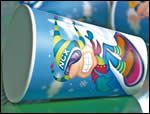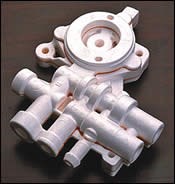Smaller EPS Beads Make Thinner Walls In Cups, Casting Patterns and Cushioning
Smaller is proving to be better in several different areas of expandable bead molding.
Smaller is proving to be better in several different areas of expandable bead molding. Smaller beads are helping to make EPS cups more competitive with paper cups by allowing thinner walls beneath film or paper labels with high-quality printed graphics. Smaller beads also permit molding more intricate thin-wall patterns for lost-core metal casting. Smal ler beads for more intricate shapes are also a trend in resilient protective packaging.
Coffee-cup wars
Four large commercial EPS cup makers and one EPS bead producer have recently launched new dual-material cup technologies that permit the first use of all-over printing with high-quality graphics on EPS. The world’s largest foam cup producer, Dart Container Corp. in Mason, Mich., has developed an EPS cup with a paper label applied after molding. Called Fusion, this cup was introduced last June at Atlanta-based Chick-fil-A restaurants to hold the first premium coffee served by a fast-food chain. By October, the new coffee and branded cup had reportedly doubled Chick-fil-A’s coffee sales, and the cup had won first prize for graphics from the Food Service and Packaging Institute, Falls Church, Va. Dart developed the process for the cups, builds its own machinery, and has applied for patents.
Meanwhile, the world’s second largest foam cup producer, Wincup of Phoenix, Ariz., worked with Prairie Packaging Inc., Bedford Park, Ill., to introduce a paper-labeled EPS cup in test markets for McDonald’s Corp. McDonald’s rolled out a premium coffee nationwide in March and is testing even more upscale versions—lattes, espressos and cappuccinos—at a handful of McDonald’s “McCafe” locations. The labeling technology was developed by Prairie Packaging.
Grupo Convermex SA in Puebla, Mexico, the third largest foam cup maker, also recently introduced thin, “high-graphic” EPS cups, called GraphiCup, into U.S. test markets. They are made by two different methods, both developed in-house. One uses an all-over plastic in-mold label. The other applies a coated paper label to the molded cup on a mandrel, then adds external heating so that the label bonds to the cup. Convermex has applied for a U.S. patent on the latter (0060005917, Sept. 16, 2005).
“High-graphic” labeling is also available to EPS cup molders on a non-proprietary basis. Last year, bead maker Nova Chemicals Corp. acquired the “IMage” high-graphic cup technology from Autonational BV in Sneek, Netherlands. Nova is now offering the technology under license agreements. Autonational took five years to develop this in-mold labeling (IML) approach, which inserts printed labels of PP film, paper, or other materials into molds prior to injecting the beads. One type of label is a three-layer PP film with a printable surface layer and a seal layer that bonds to EPS.
All these new cup technologies are tackling “the Starbucks factor”: Paper cups with distinctive, brand-identifying graphics have significantly eroded EPS’s market share in recent years. “Premium coffee is the fastest growing coffee market segment, recently growing from 12% to 16% of total coffee consumption,” notes Debra van Holst, global packaging director at Nova, which has applied for patents on IMage technology for cups and containers. IML machinery will be built by Autonational and supplied globally through Nova under royalty agreements.
Smaller bead, thinner cup
The paper and plastic labels on these high-graphic cups provide strength and rigidity, so the EPS can be thinner. Thinner EPS walls also make for shorter stack heights, so shipping and storage costs for the new cups are reduced.
Molding thinner walls requires smaller beads. Nova’s IMage cups, for example, take a standard T bead, such as its F271T, which is pre-expanded to a lesser extent than is usual for standard “fat” EPS cups—i.e, from 40 pcf to about 6 pcf (for current prototypes) instead of the typical 3 pcf. Tooling is highly machined to give the cups very smooth inside walls of higher density EPS about three beads thick.
Molding cycles for the thin IMage cups are longer: 10 to 12 sec for 12-oz IMage cups vs. 9 to 10 sec for conventional thicker cups. Label insertion and positioning accounts for the extra time. Bead filling and expansion in the mold actually take less time with smaller beads.
“Label positioning is highly mechanical and very precise,” says IMage business manager James Fontana. Beads are pulled in with vacuum applied at the cup lip, which is farthest from the nozzle in the bottom of the cup, rather than being blown in like beads for conventional thick cups. Blowing beads would disturb the label.
Small-bead molding requires different surface treatment of beads for greater lubricity to fill thinner cavities. Smaller beads also are more fluid and pack more closely than larger beads, so more beads are used, which means more surface area. More surface area means that beads degas and emit pentane faster during molding, which shortens processing time.
A production-scale demo line with Autonational’s molding machine is installed in Nova’s product-development plant near Pittsburgh. The unit has six cavities for 12-oz cups or European 6-oz cups. A modified mold base can mold six 20-oz cups.
Each molding cell can produce six 12-oz cups in a 10- to 12-sec cycle or over 2000 cups/hr. Cups demold onto a conveyor, which can accommodate up to six molding cells side by side, leading to one cup sorter and leak tester. Total output from all six molding cells would be over 12,000 cups/hr.
Lost-core EPS molding
EPS cups aren’t the only place where smaller beads are being used to mold thinner parts. Eighteen months ago, bead maker StyroChem began offering its new X grade of bead measuring only 250 microns vs. 400 microns for a standard cup bead. X bead is used to mold thin wall sections for “lost-foam” aluminum casting of hollow metal parts, such as engine blocks, where sharply defined angles are needed. Lost-foam casting is a rapidly growing niche since General Motors began using it for engine blocks in the mid 1990s. Lost-foam grades sell at a considerable premium over standard cup beads. X beads are not for food contact because they use blowing agents that contain cyclopentane.
In addition, Nova introduced this year a 25% smaller size of its Arcel expandable bead, which consists of an interpenetrating network of 70% PS/30% PE. Arcel is used for protective packaging and durable applications. Smaller Arcel 730 bead is aimed at more intricate, thinner-walled parts. Nova found the smaller size fills molds more quickly and will soon offer Arcel only in that size.
Read Next
Beyond Prototypes: 8 Ways the Plastics Industry Is Using 3D Printing
Plastics processors are finding applications for 3D printing around the plant and across the supply chain. Here are 8 examples to look for at NPE2024.
Read MoreMaking the Circular Economy a Reality
Driven by brand owner demands and new worldwide legislation, the entire supply chain is working toward the shift to circularity, with some evidence the circular economy has already begun.
Read MoreSee Recyclers Close the Loop on Trade Show Production Scrap at NPE2024
A collaboration between show organizer PLASTICS, recycler CPR and size reduction experts WEIMA and Conair recovered and recycled all production scrap at NPE2024.
Read More













